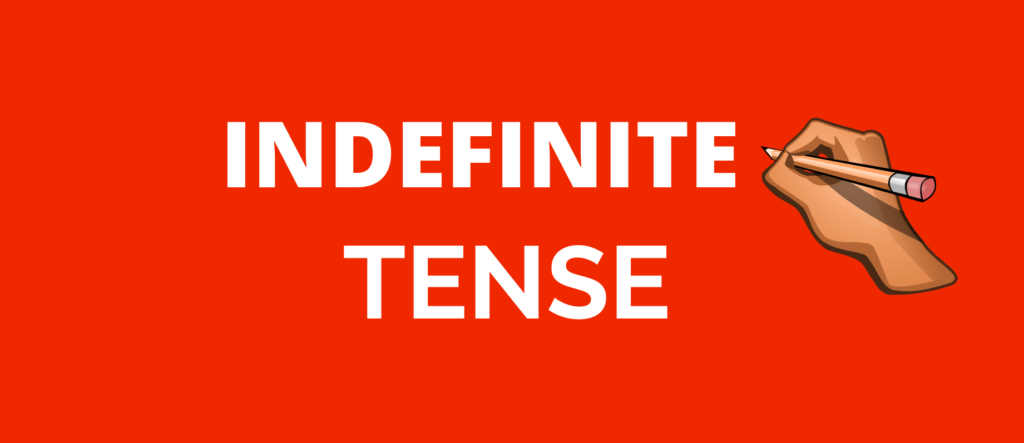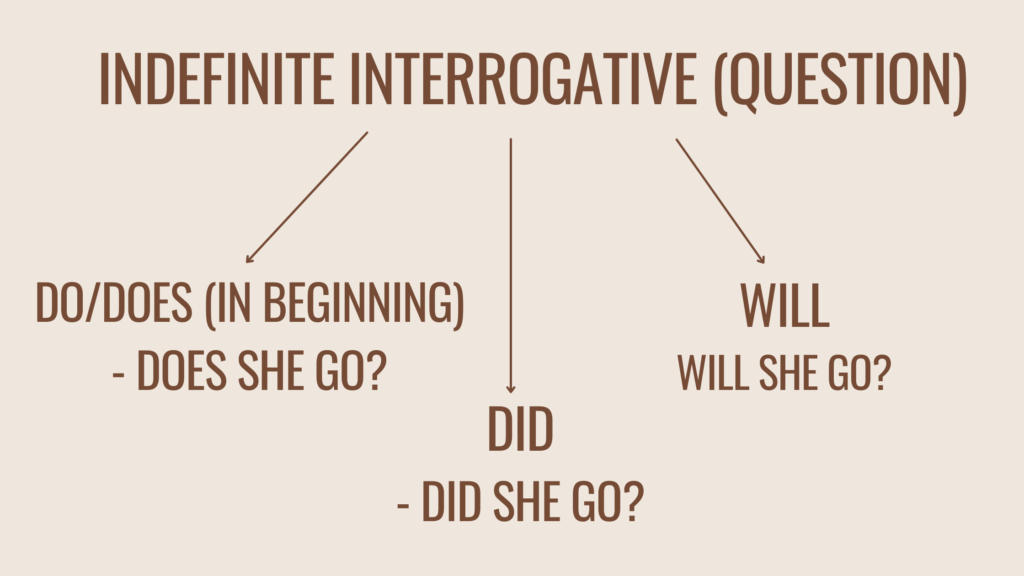
Example Of Present Indefinite Tense part-1

INTRODUCTION
The term TENSE refers to time – PRESENT, PAST, and FUTURE. In this article, (EXAMPLE OF PRESENT INDEFINITE TENSE) you will get about what is the meaning of Indefinite Tense, how it plays an important role in Tense, and what are its uses. Moreover, How we can use it in our communication officially and unofficially. Moreover, tense has 4 parts – INDEFINITE/Simple, CONTINUOUS/Imperfect, PERFECT, and PERFECT CONTINUOUS.
EXAMPLE OF PRESENT INDEFINITE TENSE (POSITIVE)
The Present Indefinite tense is all about your DAILY ROUTINE, LIKES/DISLIKES, and UNIVERSAL TRUTH. Furthermore, you have to use S/ES at the end of the VERB only with the SINGULAR SUBJECTS such as HE, SHE, IT and ONE NAME like (Neeta) and PLURAL SUBJECTS such as I, WE, YOU, THEY and NAMES (TWO OR MORE THAN TWO) here we count I as Plural because it uses plural helping verbs such as I Do, I Have and we never use S/ES with plural.

FOR EXAMPLE:-
DAILY ROUTINE – 1. (positive) Neeta takes bath.
1. P) Neeta and Ravi take bath.
2. P) Ravi pays the electricity bill.
2. P) I pay the electricity bill.
3. P) She cooks food.
3. P) We cook food.
LIKES/DISLIKES – 1. P) Shivam likes chocolate.
1. P) Shivam and Ravi like Chocolate.
2. P) Ravi likes Ice Cream.
2. P) I like Ice Cream.
3. P) He likes Candies.
3. P) They like Candies.
UNIVERSAL TRUTH – 1. P) Earth revolves around the sun.
2. P) Sunrises from the east.
EXAMPLE OF PRESENT INDEFINITE TENSE (NEGATIVE)
ABOVE you can see I have used S/ES with SINGULAR SUBJECTS, not with PLURAL SUBJECTS. Moreover, we write (Positive) or (P) in those where there is no negativity. Now we will make the rest of the THREE sentences Negative (N), Interrogative (I) means to question, and Interrogative Negative (IN) means negative question. Similarly, you have to use DO for PLURAL and DOES for SINGULAR with NOT means from Negative sentences.

FOR EXAMPLE:-
DAILY ROUTINE – 1. N) Neeta Does not take bath.
1. N) Neeta and Ravi Do not take bath.
2. N) Ravi Does not pay the electricity bill.
2. N) Meena and Ravi Do not pay the electricity bill.
LIKES/DISLIKES – 1. N) Shivam Does not like chocolate.
1. N) Shivam and Ravi Do not like Chocolate.
2. N) Ravi Does not like Ice Cream.
2. N) Ravi and Meena Do not like Ice Cream.
S/ES only applicable with SINGULAR POSITIVE SENTENCES NOT USE FROM NEGATIVE SENTENCES and also the same structure of negative can be used in UNIVERSAL TRUTH as well. Let’s make INTERROGATIVE and INTERROGATIVE NEGATIVE with plural and singular subjects both.
EXAMPLE OF PRESENT INDEFINITE TENSE (INTERROGATIVE)

DAILY ROUTINE – 1. I) Does Neeta take bath?
1. I) Do Neeta and Ravi take bath?
2. I) Does Ravi pay the electricity bill?
2. I) Do Meena and Ravi pay the electricity bill?
LIKES/DISLIKES – 1. I) Does Shivam like chocolate?
1. I) Do Shivam and Ravi like Chocolate?
2. I) Does Ravi like Ice Cream?
2. I) Do Ravi and Meena like Ice Cream?
Here we will use DO and DOES at the beginning of the sentences because you ask questions here. Moreover, we will use DO NOT and DOES NOT at the beginning of INTERROGATIVE NEGATIVE SENTENCES.
EXAMPLE OF PRESENT INDEFINITE TENSE (INTERROGATIVE NEGATIVE)
DAILY ROUTINE – 1. IN) Does not Neeta take bath?
1. IN) Do not Neeta and Ravi take bath?
2. IN) Does not Ravi pay the electricity bill?
2. IN) Do not Meena and Ravi pay the electricity bill?
LIKES/DISLIKES – 1. IN) Does not Shivam like chocolate?
1. IN) Do not Shivam and Ravi like Chocolate?
2. IN) Does not Ravi like Ice Cream?
2. IN) Do not Ravi and Meena like Ice Cream?
PAST INDEFINITE TENSE (POSITIVE)
Furthermore, In PAST INDEFINITE you have to use V2.
DAILY ROUTINE – 1. N) Neeta took bath.
1. P) Neeta and Ravi took bath.
2. P) Ravi paid the electricity bill.
2. P) Meena and Ravi paid the electricity bill.
LIKES/DISLIKES – 1. P) Shivam liked chocolate.
1. P) Shivam and Ravi liked Chocolate.
2. P) Ravi liked Ice Cream.
2. P) Ravi and meena liked Ice Cream.
Here TAKE will turn into TOOK, LIKE – LIKED, PAY – PAID, etc.
PAST INDEFINITE TENSE (NEGATIVE, INTERROGATIVE, AND INTERROGATIVE NEGATIVE)
Similarly, From NEGATIVE Do and Does will change into DID, and did will use with both (singular + plural subjects). Similarly, you have to remove V2 from negative after DID we never use v2 because DID is already V2.
SINGULAR SUBJECT
DAILY ROUTINE – 1. N) Neeta Did not take bath.
- I) Did Neeta take bath?
1. IN) Did not Neeta take bath?
LIKES/DISLIKES – 1. N) Shivam Did not like chocolate.
1. I) Did Shivam like chocolate?
1. IN) Did not Shivam like chocolate?
PLURAL SUBJECT
2. N) Neeta and Ravi Did not take bath.
2. I) Did Neeta and Ravi take bath?
2. IN) Did not Neeta and Ravi take bath?
LIKES/DISLIKES 2. N) Shivam and Ravi Did not like chocolate.
2. I) Did Shivam and Ravi like chocolate?
2. IN) Did not Shivam and Ravi like chocolate?
FUTURE INDEFINITE TENSE (POSITIVE, NEGATIVE, INTERROGATIVE, AND INTERROGATIVE NEGATIVE)
Now at last we have a future of indefinite you have to use WILL with both (singular + plural).
SINGULAR SUBJECT
DAILY ROUTINE – 1. N) Neeta Will take bath.
1. N) Neeta Will not take bath.
- I) Will Neeta take bath?
1. IN) Will not Neeta take bath?
LIKES/DISLIKES – 1. P) Shivam Will take chocolate.
1. N) Shivam Will not like chocolate.
1. I) Will Shivam like chocolate?
1. IN) Will not Shivam like chocolate?
PLURAL SUBJECT
1. P) Neeta and Ravi Will take bath.
1. N) Neeta and Ravi Will not take bath.
1. I) Will Neeta and Ravi take bath?
1. IN) Will not Neeta and Ravi take bath?
LIKES/DISLIKES – 1. P) Shivam and Ravi Will like Chocolate.
1. N) Shivam and Ravi Will not like chocolate.
1. I) Will Shivam and Ravi like chocolate?
1. IN) Will not Shivam and Ravi like chocolate?
CLICK HERE ON THIS LINK FOR CONTINUOUS TENSE PART-2
CLICK HERE TO KNOW HOW TO GET FLUENCY IN YOUR COMMUNICATION SKILLS
Indefinite Tense is all about your ROUTINE WORK, LIKES/DISLIKES and UNIVERSAL TRUTH.
PRESENT INDEFINITE – present routine & likes/dislikes. for example – he likes chocolate.
PAST INDEFINITE – past routine & likes/dislikes. for example – he liked chocolate.
FUTURE INDEFINITE – future routine & likes/dislikes. for example – he will like chocolate.
PRESENT CONTINUOUS – the work which is going on at present. for example – the fan is moving.
PAST CONTINUOUS – the work which was going on in past. for example – the fan was moving.
FUTURE CONTINUOUS – the work which will be going on in the future. for example – the fan will be moving.
PRESENT PERFECT – the work which has completed at present recently. for example – the project has completed.
PAST PERFECT – the work which had completed in the past earlier. for example – the project had completed.
FUTURE PERFECT – the work which will have completed in the future. for example – the project will have completed.
PRESENT PERFECT CONTINUOUS – the work or action which started in past and still continues in present. for example – she has been working in this company for 2 years.
PAST PERFECT CONTINUOUS – the work or action which started in past and also completed in past. for example – she had been working in this company for 2 years.
FUTURE PERFECT CONTINUOUS – the work or action which will start in the future and will continue in the future. for example – she will have been working in this company for 2 years.
The concept of tense in English refers to time – past, present, and future. Tense are 4 types – Indefinite, continuous perfect, and perfect continuous.
MORE QUESTIONS
There are three types of present indefinite tense – routine work/daily routine, likes/dislikes and universal truth.
Indefinite tense is called Indefinite tense because it talks about your daily routine and simple work which you do on a daily basis.
The structure of present indefinite tense – sub+v1+s/es+obj.
The formula of past indefinite tense is – sub+v2+obj.
We use do/does from negative sentences in indefinite. Do with plural and Does with singular. For example – she doesn’t like dark chocolate and I don’t like ice cream.
The example of indefinite sentences are as follows:-
1. she takes bath.
2. we cook food.
3. Meena goes market.
4. Rajeev and shivam take tea everyday.
5. Ranjana meets her friend.
YES, Simple tense or Indefinite are same. You can use either Indefinite or Simple.
A work or routine which you follow in future. For example – she will go to GYM every morning.
